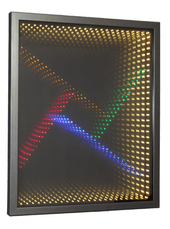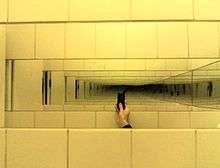Infinity mirror



An infinity mirror is a pair of parallel mirrors, which create a series of smaller and smaller reflections that appear to recede into an infinite distance.[1][2] They are used as room accents and in artwork.[3]
Description
In a classic self-contained infinity mirror, a set of light bulbs, LEDs, or other point-source lights are placed around the periphery of a fully reflective mirror, and a second, partially reflective "one-way mirror" is placed a short distance in front of it, in a parallel alignment. When an outside observer looks into the surface of the partially reflective mirror, the lights appear to recede into infinity, creating the appearance of a tunnel of lights of great depth.[2]
Alternatively, this effect can also be seen when an observer stands between two parallel fully reflective mirrors, as in some dressing rooms, some elevators, or a house of mirrors.[1] A weaker version of this effect can be seen by standing between any two parallel reflective surfaces, such as the glass walls of a small entry lobby into some buildings. The partially reflective glass produces this sensation, diluted by the visual noise of the views through the glass into the surrounding environment.
Explanation of effect
The infinity mirror effect is produced whenever there are two parallel reflective surfaces which can bounce a beam of light back and forth an indefinite (theoretically infinite) number of times. The reflections appear to recede into the distance because the light actually is traversing the distance it appears to be traveling.
For example, in a two-centimeter-thick infinity mirror, with the light sources halfway between, light from the source initially travels one centimeter. The first reflection travels one centimeter to the rear mirror and then two centimeters to, and through the front mirror, a total of three centimeters. The second reflection travels two centimeters from front mirror to back mirror, and again two centimeters from the back mirror to, and through the front mirror, totaling four centimeters, plus the first reflection (three centimeters) making the second reflection seven centimeters away from the front mirror. Each successive reflection adds four more centimeters to the total (the third reflection appears 11 centimeters deep, fourth 15 centimeters deep, and so on).[1][4]
Each additional reflection adds length to the path the light must travel before exiting the mirror. If the mirrors are not precisely parallel, but instead are canted at a slight angle, the "visual tunnel" will be perceived to be curved (off to one side) as it recedes into infinity.
When studied using the principles of geometrical optics, the series of repeating images forms the infinite mathematical surface known as Gabriel's Horn, or Torricelli's Trumpet, named in honor of Italian mathematician Evangelista Torricelli, who first studied it. In theory, such a surface is infinite in area, but encloses a finite volume.[1]
Cultural references
Visual artists, especially contemporary sculptors, have made use of infinity mirrors. Yayoi Kusama, Josiah McElheny, Ivan Navarro, and Taylor Davis have all produced works that use the infinity mirror to expand the sensation of unlimited space in their artworks.
See also
References
- 1 2 3 4 Gbur, Gregory J. (July 30, 2011). "Infinity is weird… even in infinity mirrors!". Skulls in the Stars: The intersection of physics, optics, history and pulp fiction. Retrieved 2015-06-04.
- 1 2 Finio, Ben. "Arduino-controlled RGB LED Infinity Mirror". Instructables. Autodesk, Inc. Retrieved 2015-06-04.
- ↑ Grimes, William (December 1, 2013). "Lights, Mirrors, Instagram! #ArtSensation". The New York Times. The New York Times Company. Retrieved 2015-06-04.
- ↑ "Look Into Infinity". Exploratorium Snacks. Exploratorium. Retrieved 2015-06-04.